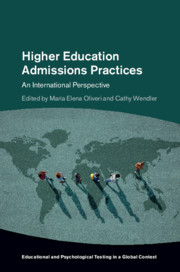Book contents
- Higher Education Admissions Practices
- Educational and Psychological Testing in a Global Context
- Higher Education Admissions Practices
- Copyright page
- Contents
- Figures
- Tables
- Contributors
- Series Editor’s Foreword
- Foreword
- Acknowledgments
- Part I Global Challenges and Common Admissions Models
- Part II Country-Specific Admissions Practices
- Chapter 7 Admissions Policies and Practices and the Reshaping of Access Patterns to Higher Education in Africa
- Chapter 8 Chile’s Admissions Tests: Pending Changes and Revisions
- Chapter 9 Issues of Perceived Fairness in Admissions Assessments in Small Countries: The Case of the Republic of Cyprus
- Chapter 10 Higher Education Admissions Practices in Israel
- Chapter 11 Access, Equity, and Admissions in South African Higher Education
- Chapter 12 Admissions Practices in Sweden
- Chapter 13 Revisions of Admissions Testing in Vietnam: From Elite to Mass Higher Education
- Part III Assessments Used in Higher Education Admissions
- Part IV Rethinking Higher Education Admissions
- Index
- References
Chapter 10 - Higher Education Admissions Practices in Israel
from Part II - Country-Specific Admissions Practices
Published online by Cambridge University Press: 09 January 2020
- Higher Education Admissions Practices
- Educational and Psychological Testing in a Global Context
- Higher Education Admissions Practices
- Copyright page
- Contents
- Figures
- Tables
- Contributors
- Series Editor’s Foreword
- Foreword
- Acknowledgments
- Part I Global Challenges and Common Admissions Models
- Part II Country-Specific Admissions Practices
- Chapter 7 Admissions Policies and Practices and the Reshaping of Access Patterns to Higher Education in Africa
- Chapter 8 Chile’s Admissions Tests: Pending Changes and Revisions
- Chapter 9 Issues of Perceived Fairness in Admissions Assessments in Small Countries: The Case of the Republic of Cyprus
- Chapter 10 Higher Education Admissions Practices in Israel
- Chapter 11 Access, Equity, and Admissions in South African Higher Education
- Chapter 12 Admissions Practices in Sweden
- Chapter 13 Revisions of Admissions Testing in Vietnam: From Elite to Mass Higher Education
- Part III Assessments Used in Higher Education Admissions
- Part IV Rethinking Higher Education Admissions
- Index
- References
Summary
The higher-education system in Israel is governed by The Council for Higher Education and is mainly merit-based. This chapter discusses the practices used in Israel for admissions into higher education institutions, the use of the Bagrut Certificate as part of admissions, and fairness and psychometric issues related to the admissions examination, the Psychometric Entrance Test. The chapter also describes challenges surrounding Psychometric Entrance Test and the various reform efforts.
Keywords
- Type
- Chapter
- Information
- Higher Education Admissions PracticesAn International Perspective, pp. 174 - 189Publisher: Cambridge University PressPrint publication year: 2020
References
- 5
- Cited by



